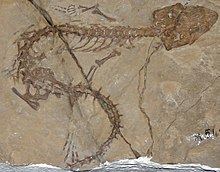
Rhynchocephalia is an order of lizard-like reptiles that includes only one living species, the tuatara of New Zealand. Despite its current lack of diversity, during the Mesozoic rhynchocephalians were a speciose group with high morphological and ecological diversity. The oldest record of the group is dated to the Middle Triassic around 238 to 240 million years ago, and they had achieved global distribution by the Early Jurassic. Most rhynchocephalians belong to the group Sphenodontia ('wedge-teeth'). Their closest living relatives are lizards and snakes in the order Squamata, with the two orders being grouped together in the superorder Lepidosauria.

Homoeosaurus is an extinct genus of rhynchocephalian reptile, known from the Late Jurassic-earliest Cretaceous of Europe, with specimens being reported from France, England and Germany. Several species have been described within the genus, based on varying proportions of the limb bones to the body length based on the presacral vertebrae. Specimen C.M.6438 of H. maximiliani from Germany has a total length of around 17 centimetres (6.7 in), with a skull length of about 1.7 centimetres (0.67 in). In comparison to other rhynchocephalians, the limbs are proportionally long. Recent studies have classified Homoeosaurus as a member of Neosphenodontia, with some studies including it as part of the clade Leptorhynchia, also including sapheosaurs, pleurosaurs, Kallimodon and Vadasaurus. Despite being found in aquatic deposits, it is suggested to have been terrestrial. It is thought to have been a carnivore/insectivore. One specimen was found as stomach contents of the fish Belonostomus.
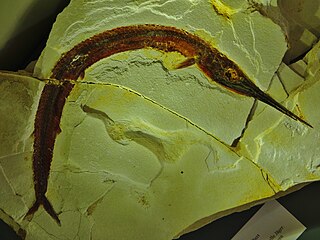
Belonostomus is a genus of prehistoric ray-finned fish that was described by Louis Agassiz in 1844. It is a member of the order Aspidorhynchiformes, a group of fish known for their distinctive elongated rostrums.

Brachyrhinodon is an extinct genus of sphenodontian from the Late Triassic Lossiemouth Sandstone of Scotland.

Clevosaurus is an extinct genus of rhynchocephalian reptile from the Late Triassic and the Early Jurassic periods. Species of Clevosaurus were widespread across Pangaea, and have been found on all continents except Australia and Antarctica. Five species of Clevosaurus have been found in ancient fissure fill deposits in south-west England and Wales, alongside other sphenodontians, early mammals and dinosaurs. In regards to its Pangaean distribution, C. hadroprodon is the oldest record of a sphenodontian from Gondwana, though its affinity to Clevosaurus has been questioned.
Cladocyclus is an extinct genus of marine ichthyodectiform fish from the middle Cretaceous. It was a predatory fish of about 1.20 metres (3.9 ft) in length.

Chirocentrites is an extinct genus of marine ray-finned fish in the order Ichthyodectiformes. It contains a single species, C. coroninii, from the Late Cretaceous (Cenomanian) of Slovenia. A potential specimen is also known from the Albian-aged Pietraroja Plattenkalk of southern Italy, but it has been suggested that this specimen actually represents Cladocyclus.
Caeus is an extinct genus of prehistoric marine ray-finned fish, closely related to the modern milkfish. It contains a single species, C. leopoldi from the Early Cretaceous of the Pietraroja Plattenkalk, Italy. It is one of the largest teleosts known from the Pietraroja formation, and is known by only a single specimen.
Hylaeochampsa is an extinct genus of eusuchian crocodylomorphs. It is known only from a partial skull recovered from Barremian-age rocks of the Lower Cretaceous Vectis Formation of the Isle of Wight. This skull, BMNH R 177, is short and wide, with a eusuchian-like palate and inferred enlarged posterior teeth that would have been suitable for crushing. Hylaochampsa was described by Richard Owen in 1874, with H. vectiana as the type species. It may be the same genus as the slightly older Heterosuchus, inferred to have been of similar evolutionary grade, but there is no overlapping material as Heterosuchus is known only from vertebrae. If the two could be shown to be synonyms, Hylaeochampsa would have priority because it is the older name. Hylaeochampsa is the type genus of the family Hylaeochampsidae, which also includes Iharkutosuchus from the Late Cretaceous of Hungary. James Clark and Mark Norell positioned it as the sister group to Crocodylia. Hylaeochampsa is currently the oldest known unambiguous eusuchian.
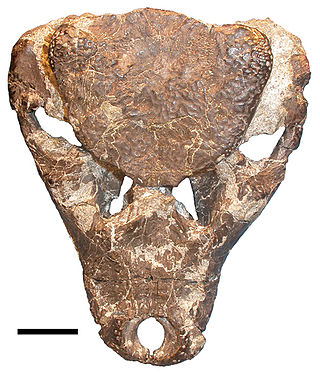
Hylaeochampsidae is an extinct family of basal eusuchian crocodylomorphs thought to be closely related to the order Crocodylia.

Opisthias is a genus of sphenodont reptile. The type species, Opisthias rarus, is known from the Late Jurassic (Kimmeridgian-Tithonian) of western North America.
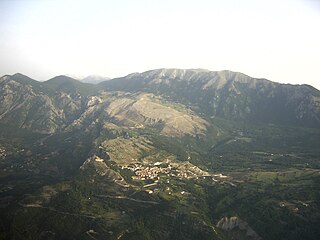
The Pietraroia Plattenkalk is a Cretaceous geologic formation located in the Italian municipality of Pietraroja, near Benevento, in Campania region. It is of Albian age. Dinosaur remains diagnostic to the genus level are among the fossils that have been recovered from the formation and the type locality of the formation is the La Cavere quarry, which is near the village of Pietraroja.
Godavarisaurus is an extinct genus of sphenodontian reptile from the Early-Middle Jurassic Kota Formation of Andhra Pradesh, India. It is known from jaw fragments. It was a small sphenodontian, with the skull estimated to be less than 2 centimetres (0.79 in) long. It is generally considered to be a relatively basal sphenodontian that lies outside Eusphenodontia.
Paluxysuchus is an extinct genus of neosuchian crocodyliform known from the Early Cretaceous Twin Mountains Formation of north-central Texas. It contains a single species, Paluxysuchus newmani. Paluxysuchus is one of three crocodyliforms known from the Early Cretaceous of Texas, the others being Pachycheilosuchus and an unnamed species referred to as the "Glen Rose Form". Paluxysuchus has a long, flat skull that is probably transitional between the long and narrow skulls of many early neosuchians and the short and flat skulls of later neosuchians.
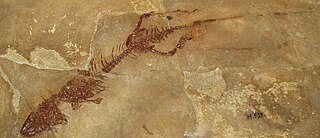
Chometokadmon is an extinct genus of anguimorph lizard from the Early Cretaceous of Italy. The type and only species is Chometokadmon fitzingeri, named by Italian zoologist Oronzio Gabriele Costa in 1864. It is known from only one specimen, a nearly complete skeleton from the comune of Pietraroja in the Apennine Mountains from the sediments of the Pietraroia Plattenkalk. Costa identified the specimen as a lizard, but in 1915 paleontologist Geremia d'Erasmo reclassified the skeleton as that of a rhynchocephalian on the basis of another rhynchocephalian specimen Costa had described, which d'Erasmo thought belonged to the same species. Later studies of the anatomy of these two specimens revealed that they belonged to two different species; Costa's Chometokadmon was a lizard whereas the other specimen, renamed Derasmosaurus in honor of d'Erasmo, was a rhynchocephalian. The first detailed description of Chometokadmon came in 2006, allowing it to be incorporated into a phylogenetic analysis of lizards. The analysis placed Chometokadmon as a member of the clade Anguimorpha, which includes Anguidae, Xenosauridae, and Varanoidea.
Rebbanasaurus is an extinct sphenodontian reptile known from remains found in the Early-Middle Jurassic Kota Formation of India. The type specimen is a partial jawbone which has acrodont teeth, with other known remains including fragments of the premaxilla, maxilla, and palatine. It was relatively small, with a skull estimated at 1.5–2.5 centimetres (0.59–0.98 in) long. It is generally considered to be a relatively basal sphenodontian that lies outside Eusphenodontia.

Eichstaettisaurus is a genus of lizards from the Late Jurassic and Early Cretaceous of Germany, Spain, and Italy. With a flattened head, forward-oriented and partially symmetrical feet, and tall claws, Eichstaettisaurus bore many adaptations to a climbing lifestyle approaching those of geckoes. The type species, E. schroederi, is among the oldest and most complete members of the Squamata, being known by one specimen originating from the Tithonian-aged Solnhofen Limestone of Germany. A second species, E. gouldi, was described from another skeleton found in the Matese Mountains of Italy. Despite being very similar to E. schroederi, it lived much later, during the Albian stage. Fossils of both species show exceptional preservation due to deposition in low-oxygen marine environments.

Opisthodontia is a proposed clade of sphenodontian reptiles, uniting Opisthias from the Late Jurassic-earliest Cretaceous of Europe and North America with the Eilenodontinae, a group of herbivorous sphenodontians known from the Late Triassic to Late Cretaceous.

Sapheosaurs are an extinct group of rhynchocephalian reptiles from the Late Jurassic period. "Sapheosaurs" is an informal name for a group of rhynchocephalians closely related to the genus Sapheosaurus. It was first recognized as a group containing multiple genera by Hoffstetter in 1955. The group has sometimes been given a formal taxonomic name as the family Sapheosauridae, although in some analyses this group belongs to the family Sphenodontidae and thus cannot be assigned its own family. They were fairly advanced rhynchocephalians which may have had semiaquatic habits.
Kawasphenodon is an extinct genus of sphenodontian reptile, known from the Late Cretaceous and Paleocene of Patagonia in South America. The type species, K. expectatus, was described in 2005 from jaw fragments found in late Campanian aged sediments in the Los Alamitos Formation, the jaw when complete was estimated to be 11 cm long, making it among the largest known sphenodontians. A second species, K. peligrensis, around 1/3 the size of the type species, was described in 2014 also from jaw fragments in early Paleocene (Danian) sediments of the Salamanca Formation, making it the youngest known definitive representative of Rhynchocephalia outside of New Zealand. In the original description, it was found to be a member of Sphenodontidae, in some other subsequent analyses it was found to be a member of Opisthodontia. A 2020 analysis of rhyncocephalian relationships found it to be outside Opisthodontia, and instead a member of the Sphenodontinae as the closest known relative of the tuatara, with an estimated divergence between the two genera in the Early Cretaceous. Other subsequent studies have endorsed its placement as a member of Sphenodontidae. Like most other rhynchocephalians, the teeth are acrodont, with a deep dentary, and it probably had an omnivorous habit.
